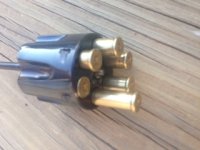Hello all: I have a situation I need some help on. About six months ago I bought a very nice .357 Magnum serial number S95473, 8 3/8 barrel. It appears hardly ever, if ever fired, but had a couple of scratches on the barrel that appear to be caused by a sharp metal object. Not collector quality, but still a great looking gun. No turn line, no cartridge marks on face of frame.
Upon firing I found that I had to pound the empties out of the cylinder. One chamber was pretty good, the other five were most difficult. This with several different brands of factory ammo. My reloads with coated 158 grain bullets and 13 grains of 2400 acted the same way.
Today, I tried to insert empty cartridges from my reload that I shot from 27-2 that extracted easily. I am attaching a picture (i hope). One chamber would readily accept the fired cartridges. The other chambers varied from a not much to a little in accepting the empties. I tried measuring the chambers with a caliper. OK, maybe not the best way, but I think I can get pretty close. The chamber where the empty completely inserted measured .379 the rest measured .3785, .376,.379, .379, and .379. But, that is at the insertion point, not where they are sticking. I measured the throats and they are almost uniform at .356.
I measured the insertion points of the cylinder the empties were fired from and they ran .3785 to .380. I also ran the empties through several other .357 Magnums I have. They pretty easily went into a 1935 RM, a couple of 1950s .357s, a 627 PC and would not quite go entirely into a 627-5.
I removed the extractor, thinking that might be part of the problem. The empties would insert farther without the extractor, but would still stick out about 3/4 of an inch.
Chambers are clean, no .38 ring, timing is good, chambers line up with barrel, no endshake, etc. No visual indication of any problems in the chambers, no tactile indication of bulging.
It seems to me that I have five tight chambers. Any ideas? Can the cylinder be reamed? Who would do it? I do not want to replace the cylinder.
I would appreciate any observations or questions.
Thanks for reading all this.
Upon firing I found that I had to pound the empties out of the cylinder. One chamber was pretty good, the other five were most difficult. This with several different brands of factory ammo. My reloads with coated 158 grain bullets and 13 grains of 2400 acted the same way.
Today, I tried to insert empty cartridges from my reload that I shot from 27-2 that extracted easily. I am attaching a picture (i hope). One chamber would readily accept the fired cartridges. The other chambers varied from a not much to a little in accepting the empties. I tried measuring the chambers with a caliper. OK, maybe not the best way, but I think I can get pretty close. The chamber where the empty completely inserted measured .379 the rest measured .3785, .376,.379, .379, and .379. But, that is at the insertion point, not where they are sticking. I measured the throats and they are almost uniform at .356.
I measured the insertion points of the cylinder the empties were fired from and they ran .3785 to .380. I also ran the empties through several other .357 Magnums I have. They pretty easily went into a 1935 RM, a couple of 1950s .357s, a 627 PC and would not quite go entirely into a 627-5.
I removed the extractor, thinking that might be part of the problem. The empties would insert farther without the extractor, but would still stick out about 3/4 of an inch.
Chambers are clean, no .38 ring, timing is good, chambers line up with barrel, no endshake, etc. No visual indication of any problems in the chambers, no tactile indication of bulging.
It seems to me that I have five tight chambers. Any ideas? Can the cylinder be reamed? Who would do it? I do not want to replace the cylinder.
I would appreciate any observations or questions.
Thanks for reading all this.

